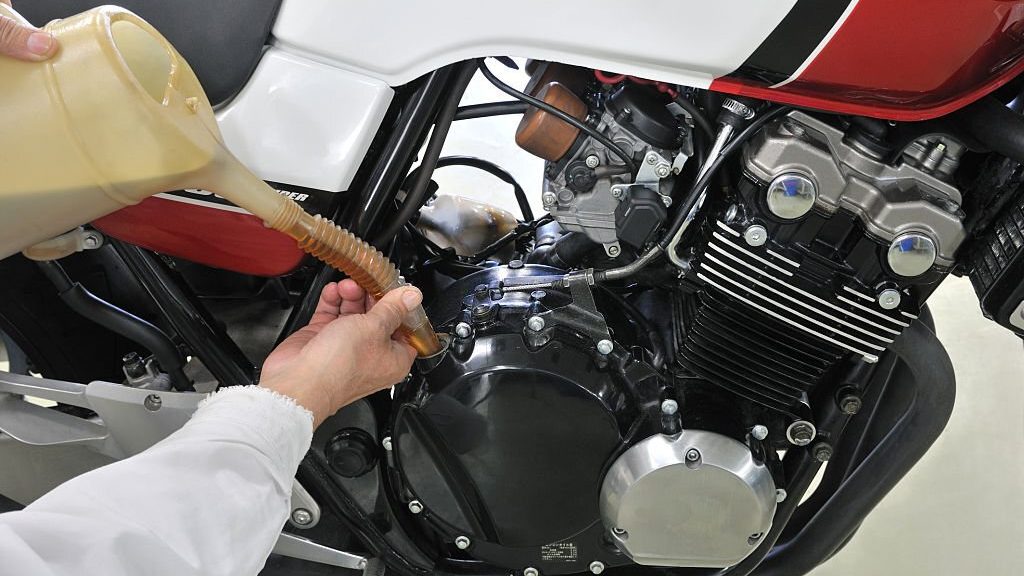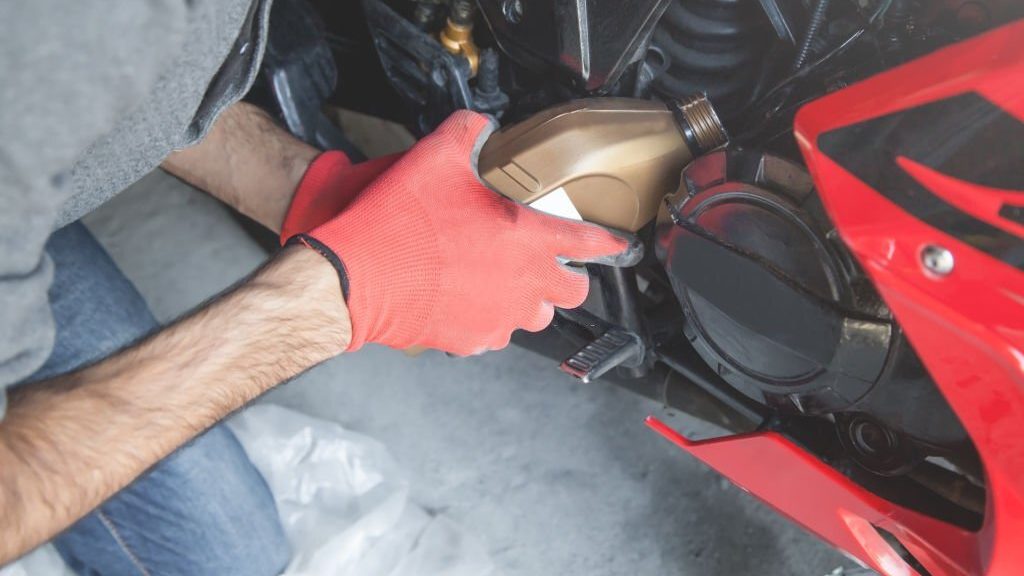One of life’s greatest thrills is revving up a motorbike and feeling the wind whip past your face.
However, remember that your bike needs regular maintenance to function properly. Knowing how often you need to replace the oil on a motorbike is an important part of keeping it in good working order.
Oil is an essential component of your motorcycle’s engine since it lubricates, cools, decreases friction, and flushes out pollutants that can cause harm.
However, the oil’s lifespan can change depending on a number of variables, such as the oil’s quality, the age and model of the motorcycle, and the conditions under which it is ridden.

In this detailed guide, you’ll learn how often you should replace your motorcycle’s oil to keep your bike in tip-top form and operating smoothly.
Start your engines, because we’re about to take off!
Why Motorcycle Oil Matters
When it comes to keeping your motorbike in top condition, the right oil for a motorbike can make all the difference. Motorcycle oil is critical in lubricating the engine, reducing friction, and removing contaminants that can cause damage over time.
With the high-performance demands of a motorbike, choosing the right oil is essential to ensure optimal engine function and longevity.
Not all oils are created equal, and selecting the right one for your bike can be daunting. But with the right knowledge, you can make an informed choice and keep your motorbike running like a dream.
For example, if you’re wondering “how fast is 250cc,” you’ll want to choose an oil that can withstand the high RPMs and temperatures that come with high-performance engines like these.
What Are the Different Types of Motorcycle Oil?

1. Mineral
Mineral oil is the most basic and commonly used type of motorcycle oil. It’s made from crude oil and undergoes minimal processing.
Mineral oil is usually the most affordable option and is suitable for older or low-performance bikes. However, its lower heat resistance and viscosity stability may not be the best choice for high-performance or newer bikes.
2. Synthetic
Synthetic oil is a man-made oil formulated to offer superior performance to mineral oil. It’s chemically engineered for better lubrication, oxidation resistance, and temperature stability.
Synthetic oil is the go-to choice for high-performance motorcycles, as it can withstand high temperatures and extreme conditions. While it may be more expensive than mineral oil, the added benefits make it worth the investment.
3. Semi-Synthetic
Semi-synthetic oil is a blend of mineral and synthetic oil. It offers some of the benefits of synthetic oil at a lower cost, making it an excellent choice for mid-range motorcycles.
The blend of mineral and synthetic oil provides improved performance compared to mineral oil but at a lower cost than fully synthetic oil.
How To Choose the Best Motorcycle Oil for Your Bike

Here are a few key factors to consider when selecting the best oil for your motorcycle:
• Motorcycle weight: Your bike’s weight is crucial in selecting the right oil viscosity. The oil must have the correct thickness to lubricate your engine’s moving parts.
• Oil Type: Three primary types of motorcycle oil are available: mineral, synthetic, and semi-synthetic. Synthetic oils offer the best protection and performance, while mineral oils are less expensive but less effective in extreme temperatures. Semi-synthetic oils offer a good balance between the two.
• Viscosity: Viscosity refers to the oil’s thickness or resistance to flow. The viscosity you choose depends on your bike’s weight, engine design, and typical riding conditions. Thicker oils provide better protection in high-temperature environments, while thinner oils improve fuel efficiency.
How Often Does Motorcycle Oil Need to Be Changed?
One of the most critical aspects of maintaining a motorcycle is ensuring that the motorbike oil is changed regularly.
Different types of oil have different recommended intervals for oil changes.
Mineral oil should be changed every 2000 to 3000 kilometers. However, semi-synthetic oil should be changed every 5,000 to 6,000 miles and has a somewhat longer lifespan. Synthetic oil allows you to go between 7,000 and 10,000 miles between oil changes.
How do I Know When My Motorcycle Needs Oil Change?

The Oil is Thin And Dark Or Black
When the oil in your motorcycle is thin, dark, or even black, it’s time to change it. Loss of viscosity is a sign that oil has been in use for a long period, collecting dirt and debris along the way.
Because of this, the oil’s ability to keep the engine running smoothly and clean itself is diminished. Loss of oil’s viscosity can accelerate engine wear, which can eventually cause irreversible damage.
To avoid this, checking your motorcycle engine oil regularly and changing it as needed is important.
Decrease in Volume of Engine Oil
Another sign that your motorcycle needs an oil change is a decrease in engine oil volume. Over time, the engine oil can evaporate or burn off, which reduces the overall amount of oil in the system.
This can lead to increased engine friction and heat, which can cause damage to the engine if left unchecked.
High Engine Temperature
A high engine temperature indicates that your motorcycle may need an oil change.
When the oil in the engine becomes old and contaminated, it can lead to increased friction and heat, which can cause the engine to overheat.
If your engine temperature is consistently higher than usual, it may be time to change your oil.
Harsh Engine Sound
Finally, a harsh engine sound indicates that your motorcycle may need an oil change. When the engine oil becomes old and contaminated, it can cause increased friction and wear on the engine, leading to a harsh, grinding sound.
This indicates that your engine is not running smoothly and that an oil change is necessary.
What Purpose Does Motor Oil Serve?
In addition to being a lubricant, motor oil serves several other important purposes in a motorcycle.

It acts as a cooling agent by dissipating heat generated by the engine and prevents rust and corrosion from forming on the engine’s surfaces.
Oil can also help seal tiny gaps between engine parts, improving efficiency and performance.
Whether pushing the Honda Grom at top speed or cruising leisurely down the highway, regular oil changes are necessary to maintain your bike’s longevity and ensure a smooth ride.
So, keep your motor oil in check and enjoy your ride!
What About Bikes That Don’t Get Used Often?
If you’re a rider who doesn’t use your bike as your primary mode of transportation, you might be wondering about oil changes in motorcycle frequency.
Motorcycles that sit idle for long periods can still accumulate moisture and other contaminants in the oil, which can cause damage to the engine.
Even if you don’t ride your bike often, changing the oil at least twice a year is recommended, regardless of mileage.
This is especially true if you store your motorcycle in winter, as colder temperatures can cause the oil to thicken and become less effective.
What About Bikes That Get Heavy Use?
Bikers who frequently take long trips or use their bikes for daily commuting may need to change their oil more frequently than the standard oil change interval motorcycle.

If you fall into this category, it’s important to keep an eye on your oil’s color, texture, and mileage to determine when it’s time for an oil change.
If you notice that the oil has turned dark and gritty or if it’s been more than 3,000 miles since your last oil change, it’s time to schedule a service appointment.
A Rule of Thumb for Replacing Engine Oil
When replacing engine oil in your motorcycle, there’s a general rule of thumb to follow. Typically, synthetic motorcycle oil should be changed every 3,000 to 5,000 kilometers.
This range allows the engine to maintain its normal performance without causing long-term damage. To determine when to change the oil, consider the daily distance you travel.
If you cover 20 to 50 kilometers a day, changing your oil every one and a half months is recommended.
However, if your daily distance exceeds 50 kilometres, changing your oil monthly is best.
What Engine Oil Should I Use on My Motorcycle?
If you’re wondering what motorcycle oil is best, synthetic oil is a well-liked option for many riders, especially those with more recent motorcycles.

This kind of oil is composed of synthetic ingredients that offer high-performance engines exceptional lubrication and protection.
It’s advised to use synthetic oil for motorcycles with engines greater than 200cc because of its improved performance in harsh climates and under heavy loads.
Should I Change The Oil Filter Every Time I Change The Oil?
Yes, to answer briefly. With each oil change, you ought to acquire a fresh oil filter. As the oil travels through your engine, the oil filter filters out impurities. The filter’s efficiency might be diminished over time if it becomes clogged with particles.
An obstructed oil filter can let impurities circulate inside your engine, harming it and shortening its life.
What Happens If You Don’t Change Your Motorcycle Oil on Time?
Neglecting motorcycle oil changes can damage the engine and transmission, impair the performance, and reduce fuel economy.
Contaminated oil can cause increased friction, premature wear and tear, and engine failure. Dirty oil can cause overheating, sluggish acceleration, and decreased fuel efficiency.
Don’t neglect oil changes; they’re a small investment that can save you big bucks in the long run.
How to Change Your Motorcycle Oil: A Step-by-Step Guide

Safety First
Before changing your motorcycle’s oil, it’s essential to prioritize safety. Ensure that your motorcycle is on a level surface and away from any potential hazards. Put on protective gloves and eye gear to prevent injury.
Warm the Engine
To make the oil easier to drain, start the engine and let it run for a few minutes. This will heat the oil and allow it to flow out more efficiently. Make sure not to run the engine for too long to avoid overheating.
Drain the Oil
Next, locate the oil drain plug underneath your motorcycle. Place a container underneath to catch the oil, and remove the plug using a wrench. Allow the oil to drain completely before moving on to the next step.
Replace the Filter
Remove the old oil filter by twisting it off with an oil filter wrench. It’s essential to replace the filter every time you change the oil to ensure proper filtration and prevent contaminants from damaging your engine.
Replace the Drain Plug
Once the oil has drained completely, replace the drain plug using a new crush washer. Tighten the plug to the recommended torque specification to prevent leaks.
Add Just the Right Amount
Pour the recommended amount of new oil into the oil filler hole using a funnel. It’s crucial not to overfill the oil level, which can lead to engine damage or poor performance.
Check the Level
Start the engine and let it run for a few minutes. Turn off the engine and check the oil level using the dipstick. If necessary, add more oil to reach the correct level.
How Often Should You Change Your Motorcycle Oil FAQs
No, it is not recommended to change motorcycle oil every 2 years. The oil should be changed more frequently, depending on the manufacturer’s recommendations and usage patterns.
The lifespan of motorcycle oil varies depending on the type of oil and the motorcycle’s usage pattern. Generally, synthetic oils can last up to 10,000 km, while mineral oils need to be changed every 5,000 km.
You can check the color and consistency of the oil to determine if it’s dirty. If the oil is black and has a gritty texture, it’s time to change it. You can also use a dipstick to check the oil level and see if it’s low.
The recommended distance for changing engine oil varies based on the manufacturer’s recommendations and the motorcycle’s usage pattern. In general, the oil should be changed every 3,000 to 10,000 km.
Wrapping Up!
Regular oil changes are critical for maintaining the health of your motorcycle engine. How often to change your motorcycle oil will depend on the type of oil you use, the motorcycle’s age and usage, and the manufacturer’s recommendations.
Generally, changing your motorcycle oil every 3,000 to 5,000 miles or every six months, whichever comes first, is recommended. However, refer to your motorcycle owner’s manual for specific guidelines.
It is essential to prioritize motorcycle maintenance to ensure its longevity and prevent costly repairs down the road. Regular oil changes are an easy and inexpensive way to keep your motorcycle running smoothly.
Do you have any additional questions about motorcycle maintenance or oil changes? Let us know in the comments below.

